(Now please, if you can’t make it through this rather long winded harangue of homage, simply scroll to the end and check out the coming events at The Velaslavasay Panorama.)
I love L.A.
Most folks who come here don’t really get it. They find themselves confused and disappointed by the fact that Los Angeles isn’t like their “city.”
Well the truth is L.A. isn’t like any city.
L.A. is only like L.A.
One of its most distinctive features is that L.A. doesn’t announce itself.
Some cities (New York, Chicago, etc.) you simply walk out of your brownstone and there she is, unavoidably staring you straight in the face, “da city.”
L.A. isn’t so blatant, or user friendly. L.A. is a secret handshake club.
Chances are you know of a killer bar, or tasty little eatery or some unique oddity shop about this town, because someone, along with a handshake perhaps, “shared the secret of it” with you.
I swear, at times living in the City of Angels is just like being a 33rd Degree Mason or in the Mafia.
Except it’s cooler.
And nobody’s out to whack you.
That being said, let me treat you to one of my L.A. secret “handshakes,” and perhaps my favorite one at that; a place where the arctic wastelands are upstairs, and a miniature paradise can be stepped into out back.
The Velaslavasay Panorama is an oddity even for L.A.
It is difficult to pinpoint how long the building that the Velaslavasay occupies has been around. Dates vary from about 1915 to 1922.
Before 1934 it was known as the Mystic Theatre which served as a venue for vaudeville acts and live performances.
Then came the famous Louise Glaum.
Louise was an L.A. native lured to Chicago by her dream of becoming a great actress. And what do you know, she did.
Not only was she renowned as a stage actress of some note, she also achieved the status of a headliner on the vaudeville circuit with her dramatic readings.
The death of her younger sister at the tragically young age of 13 required her return to be with the family, and while back in L.A. Glaum, mostly out of curiosity, decided she would “play” in one of those newfangled “moving pictures” that was being shot by a local studio.
In no time due to her stage experience, she was an acknowledged “star,” and would go on to appear in over a hundred films, including in 1915, the first American film adaptation of Shakespeare’s Taming of the Shrew called The Iron Strain, opposite Dustin Farnum, another great star of the early silent period who played the lead in Cecil B. DeMille’s The Squaw Man, the first feature length film shot in Hollywood.
Farnum was a big enough star once for a young mother to remember him when naming her new born son, so though forgotten today, in a fashion he lives on in the work of Dustin Hoffman.
Glaum meantime, though making films, longed for the challenge of the stage and so in 1935 she settled on the building that would become the Velaslavasay, as the site for Louise Glaum’s Little Theater at Union Square.
Glaum labored diligently to see that the best of the New York stage came to L.A., but she also encouraged and actively sought for West Coast playwrights whose material she would produce.
She conceived of the Playhouse as a commercial enterprise as well as an acting academy, where she could give local hopefuls the benefit of her training.
The Playhouse would prove so successful that Glaum would eventually open five additional stages citywide, thus becoming one of the earliest promoters of theatre in Los Angeles.
Like her former co-star, Glaum would fade from the public eye and die in comfortable obscurity in 1970. Sadly of her hundreds of films and shorts, few survive today. Happily, though, she is honored with a star on Hollywood’s Walk of Fame.
In the late ‘30s it seems, the building became the Union Theatre, a motion picture house with a ticket price of 15¢. It continued on as the Union Theatre well into the 1950s when it was utilized as combination church and union meeting hall.
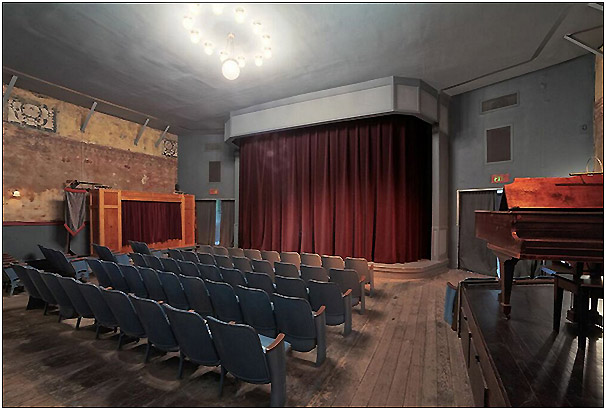
Union Theatre Interior – Photo by Sean Teegarden (Courtesy of The Velaslavasay Panorama and Gardens)
If you wander about the neighborhood, you’ll find remarkably preserved old Victorian structures mixed in with wonderful examples of Craftsman homes from the 1930s with their low roofs, exposed beams, and wide porches with a stone fireplace at one end. You’ll also find a tightly knit community of working class Latino families and other recent arrivals to the country on the path towards being new citizens.
The area nowadays sits off the 10 Freeway and has been given the new designation of “West Adams Historical District.”
Directly across from where The Velaslavasay Panorama presently sits there is another relic from L.A.’s past, a former carriage house which has survived from the days of horse drawn buggies, and is today the home of the 24th Street Theatre, one of the city’s most respected and innovative theatrical companies. (I’d like to think Louise would be pleased.)
Even driving through the area, one can tell that it is one of those special communities that have appeared over the last decade, pockets that are scattered across L.A where you’ll find an expanding bubble of revitalization, a commercial renaissance driven by a new breed of capitalist whose instincts are a curious mixture of entrepreneur and artist.
Sarah Velas and The Velaslavasay Panorama epitomize such endeavors and those who pursue them.
A native of the city, Velas was raised in the San Fernando Valley, her father was a lighting manufacturer who provided Disneyland with the means of illuminating their theme park, and frequent visits to the “Magic Kingdom” were one of her father’s perks.
Perhaps it was seeing the immaculate façades of the faux Victorian “Main Street,” and knowing the reality of the authentic structure throughout the city being demolished to make way for convenience malls that instilled in her an appreciation of the historic L.A. and its architecture. As she herself has said, “In L.A., there are only a few remnants of Victorian buildings. Because there was so little left here, it seemed more interesting.”
Studying art at Washington University in St. Louis, her fascination with the Victorian Era only intensified, and by the time she earned her Bachelor of Fine Arts degree she had found another feature of that “Gilded Age” whose scarcity in these modern times irked her: panoramic paintings.
Panoramic paintings, generally, though not always, were done on cylindrical surfaces, allowing for a 360-degree presentation on a grand scale. Their topics were mainly confined to historical events, cities, landscapes, and were typically viewed from the center under natural light, thus offering the spectator the unique opportunity of feeling immersed into the reality of the represented environment.
Though they predated the Victorian era, the popularity of panoramic exhibitions with the public reached its zenith during that epoch. For the Victorian they were the equivalent of IMAX Theatres.
In 1788 Irish artist Robert Barker premiered in Scotland his View of Edinburgh, which gave those viewing it from the center of the cylinder canvas the impression of stepping into the city itself. It was a huge success, and the next year Barker took it to London where it also attracted huge throngs.
Business was so good, that in 1793, the enterprising Irishman constructed Barker’s Panorama in London’s Leicester Square, and for the next two decades he, and then his son, would be at the forefront of this social phenomenon.
While the father was drawn to sweeping urban vistas, his son, Henry Aston Barker, specialized in battles scenes, especially those of Napoleon Bonaparte who he had met while travelling in France.
It thrilled audiences to stand in the center of Barker’s massive and realistically rendered battle scenes, and attendance to the panorama grew.
Barker’s The Battle of Waterloo was such a hit that it permitted the artist to retire. Perhaps in gratitude, Henry Aston Barker would spend some of that retirement visiting Napoleon while the former French emperor was exiled on the isle of Elba.
Barker’s Panorama would stand until 1863 when it was demolished, but panoramic painting continued to draw audiences throughout Europe and America.
As innovation has always been a surefire ingredient in “crowd drawing” the introduction of “Moving Panoramas” were as inevitable as their popularity with audiences.
The difference between a moving panorama and a stationary one was a rudimentary one; while the latter was “wrapped” around the viewers, the former was “unfolded” before them.
The canvas would be stretched between two large rollers, as one roller unfurled it the other reeled it in. Viewing the passing painting as it was wound would give a stationary audience a distinct sense of vection, the feeling that it was they who were moving.
Among the most popular themes of these was a journey down the Mississippi River, which would be depicted by at least a half dozen different moving panorama productions.
In some, the audience would actually enter the theater to take their seats in specially constructed boats on stage, which would then give the illusion of “travelling” down river in them. The addition of sound effects, music and other innovation, only heightened the experience.
It was the advent of motion pictures in the earlier 20th century that brought about the demise of the great paintings, moving or not. The huge canvases were discarded, often being sold to legitimate theatres where they would be cut into sections that were then recycled into building backdrops and sets, so today surviving examples of this unique art form are rare.
One of the very few moving panoramas still in existence is the 348 foot long The Panorama of the Monumental Grandeur of the Mississippi Valley, first shown in 1850 and now owned by the St. Louis Art Museum.
The, 1295 foot long, Grand Panorama of a Whaling Voyage Round the World painted by Benjamin Russell and Caleb Purrington in 1848, also survives and is owned by the New Bedford Whaling Museum.
The Civil War supplied a wealth of the subject matter for these massive canvases yet. Sadly, hardly any remain today of which The Battle of Atlanta by William Wehner (1896), on display in that city’s Grant Park, is one of the exceptions.
It is known that there were at least four panoramas done on the Battle of Gettysburg alone. One is reported to have been destroyed, another was rediscovered in the 1960’s and is now in the hands of private investors, a third remains lost, but a fourth has been renovated and can be enjoyed today.
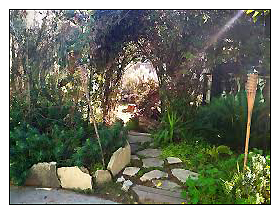
Courtesy of The Velaslavasay Panorma
Known as The Gettysburg Cyclorama by the French artist Paul Philippoteaux, the work, 42 feet in height and 377 feet in circumference depicts the climax of the three-day battle and the high-water mark for the Confederate cause, Pickett’s Charge on the final day of the clash July 3, 1863.
With the addition of a stone wall, a few trees and fences and the sculptures of fallen horses to augment the realism, the work now hangs in the new Gettysburg Museum and Visitor Center.
Velas’ enthrallment with these over-sized works of art found expression in her own Nocturnal Panorama of a Desert Landscape which was stretched across the four walls of a rectangular gallery.
Following graduation, Velas treated herself to a version of the European “Grand Tour” only hers focused on the panoramic canvases that remain, as well as the 19th-century rotundas originally built to display them.
Returning to L.A., Velas founded the The Velaslavasay Panorama initially situated on Hollywood Boulevard.
When the bulldozer of progress brought about her eviction, Velas relocated to the former vaudeville stage, former theatre, former acting school, former silent movie theatre, former church tucked away in West Adams Historical District.
And there she built something special indeed.
Entering through the foyer, one lumbers up a short spiral staircase into the former attic.
The first thing you notice as you step from the narrow stairway is the cadenced of lapping waves and the muted light with a bluish hue.
You stand on the frozen bedarken landscape of the arctic; a mulberry sea surrounds you, a pavonine blue sky above, the winds keen, the ice cracks.
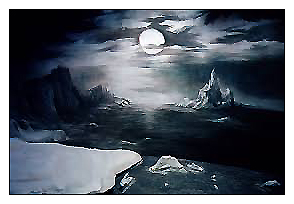
Courtesy of the Velaslavasay Panorama
You are in the rotunda Velas constructed to display Effulgence of the North, a study of light’s refulgency when reflected off an ice’s prism. A 35-minute cycle of the waves and wind whorls over the setting, evoking such an intense sense of isolation that you may need to remind yourself you’re only a stone’s throw from the 10 Freeway.
Granted, as rotundas go, this one is quite apparently petite.
But it is also one of the fewer than six panoramic scenescapes that can be experienced in the country.
Coming down from “the arctic in the attic” you cross through the old theatre that has provided a stage for everything from vaudeville acts on the Orpheum circuit to Louise Glaum’s acting students, and which is still in use today.
It’s only fitting that what comes across the stage at the Velaslavasay should be reflective of the eclecticism so pronounced in the venue itself and presentations have run the gambit with screenings in conjunction with FilmForum of the 1922 documentary Nanook of North and the experimental films of Nicolas Rey, demonstrations and discussions arranged thru Obscura Society LA about the necessities and challenges of urban beekeeping, to musical performances such as Twilight & Ghost Stories, a composition “performed in total darkness, sheet music replaced with spontaneous lighting cues.”
Moving through the stage area you’ll leave the structure and when you do, you’ll
discover yet another surprise that the Velaslavasay holds in store for you: a paradise.
Now I am not applying that term figuratively.
Our word “paradise” derives from Avestanhad, one of the oldest languages of Iran.
“Pairidaēza,” meaning “a wall enclosing a garden,” and which the crusaders brought back as “paradise.”
This garden, this “paradise” shares the same attention to form and balance present throughout the Velaslavasay.
It is a lush riot of vines, mysterious looking foliage, inviting gazebos in an utter swirl of green and shade that denotes an artist’s eye in its design.
And that artist is Sara Velas.
I’ve often thought that L.A. needed some sort of massive, imposing whatchamacallit.
You know a thingamajig that we could all be proud of and put on tee-shirts to sell to tourists. (Suckers!)
Like New York has its Statue of Liberty and San Francisco has the Golden Gate Bridge.
We need a whatchamacallit, like Mount Rushmore. But we wouldn’t put the faces of dead president up on it. (Besides North Dakota already has the best ones.)
What we would put up on Mount La-La or Mount El Laid or whatever we’d call it, would be L.A.ers.
L.A.ers who made this city the wonderful, wacky and weird place it is.
Like Abbot Kinney and Nathanael West, Charles Bukowski, Simon Rodia, David Hildebrand Wilson and Diana Drake Wilson, General Hershy Bar (aka Bill Matons), Elizabeth Short, Charles Mingus, Raymond Chandler, Buddy Collette, Clifford Clinton, James Elroy, Walter Mosey, Ray Bradbury, Kent Twitchell, David Hockey and Sara Velas.
Now these are folks who deserve a monument or at least a big ass whatchamacallit.
Sara Velas is a visual artist and the President of the International Panorama Council, an organization committed to the heritage and conservation of this art form. She is also involved with The Modern Committee of the Los Angeles Conservancy, an architectural conservation group.
♦ ♦ ♦
The Velaslavasay Panorama’s exhibits and gardens are open weekly from 10am to 6pm.
Below are a few events forthcoming to the Velaslavasay that will give you a perfect excuse to check it out:
FRIDAY, APRIL 1ST, 2016 6 P.M. ‘TIL 8 P.M.
Red Hen Press / Los Angeles Review Poetry Event
An evening of poetry read by a host of local rhymesters: Dana Gioia, Adrienne Kalfopoulou, David Mason, Lillian-Yvonne Bertram, Laurel Ann Bogen, Katherine Coles, Brendan Constantine, Nicelle Davis, Kim Dower, Ramon Garcia, Kevin Goodan, Jane Hilberry, Ron Koertge, Gary Lemons, Holaday Mason, Heather Aimee O’Neill, Jessica Schneiderman, Peggy Shumaker, Tess Taylor, Jacqueline Tchakalian, William Trowbridge, and Sarah Wetzel.
Free with RSVP
THURSDAY, APRIL 21ST, 2016 8:30 P.M.
Drag City & Dublab Present The Los Angeles Première of:
Sailing A Sinking Sea
A film by Olivia Wyatt
An experimental documentary exploring the culture and mythology of Burma’s and Thailand’s Moken community, a nomadic sea faring culture who spend much of their lives on their kabang, small hand-crafted sailing vessels. Known as “the people of the sea,” “people of the water,” and “sea gypsies,” their traditional life style is under assault by economic forces as well as the Burmese and Thai governments. Directed by Olivia Wyatt (Staring into the Sun (2011), The Pierced Heart & The Machete (2013), and a score by Bitchin’ Bajas (Drag City).
The screening will be followed by a Q&A with the director and musical performance by Frosty and Arshia Haq.
FRIDAY, MAY 6TH, 2016 AT 8 P.M.
Sid the Cat Presents: Singer/Songwriter Julianna Barwick
Barwick, who has toured with Sigur Rós, and performed with the Flaming Lips, and Yoko Ono, will be performing to celebrate the release of her fourth album.
General: $20
For additional Velaslavasay Panorama event schedules or for ticket reservations see contact information below:
Email: panorama@panoramaonview.org
Phone: 213-746-2166
Address: 1122 West 24th Street, Los Angeles, CA 90007
Website: panoramaonview.org





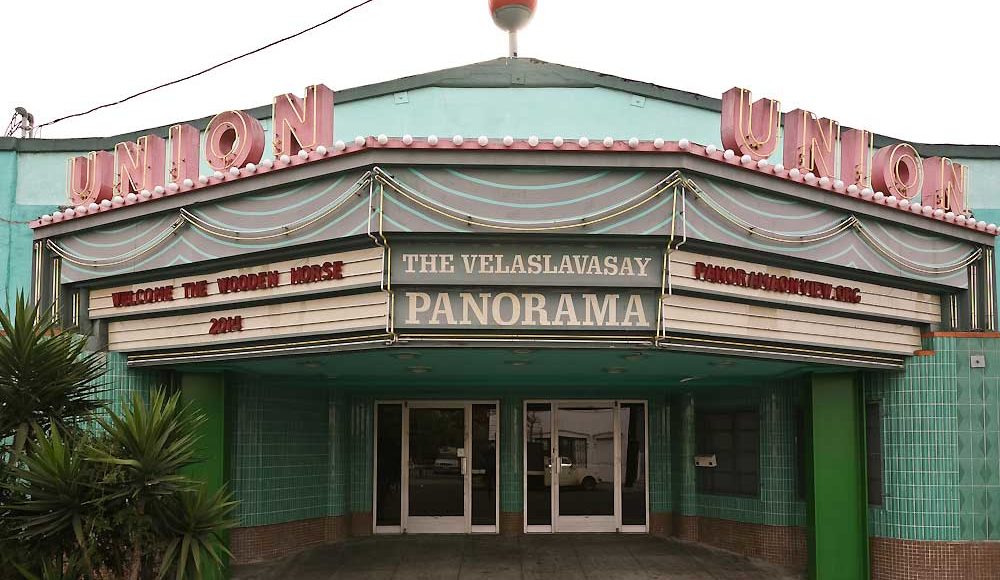
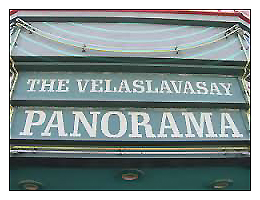
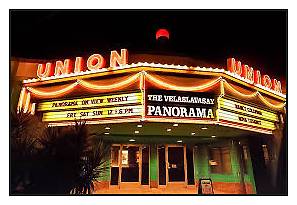
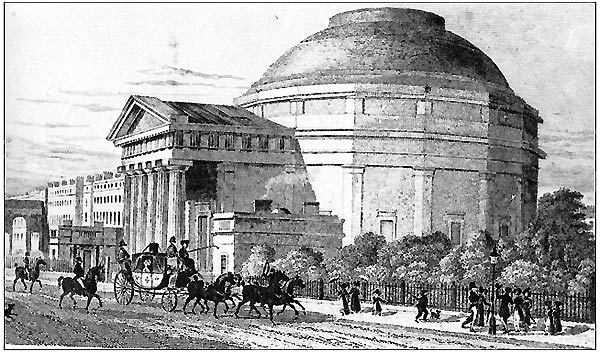

ChadSmall | February 23, 2018
|
I have checked your website and i have found some duplicate content, that’s why you
don’t rank high in google’s search results, but there is a tool
that can help you to create 100% unique articles, search for:
Boorfe’s tips unlimited content
BestHiram | February 17, 2018
|
I see you don’t monetize your page, don’t waste your
traffic, you can earn additional bucks every month because
you’ve got high quality content. If you want to know how to make extra bucks, search for: Ercannou’s essential
tools best adsense alternative